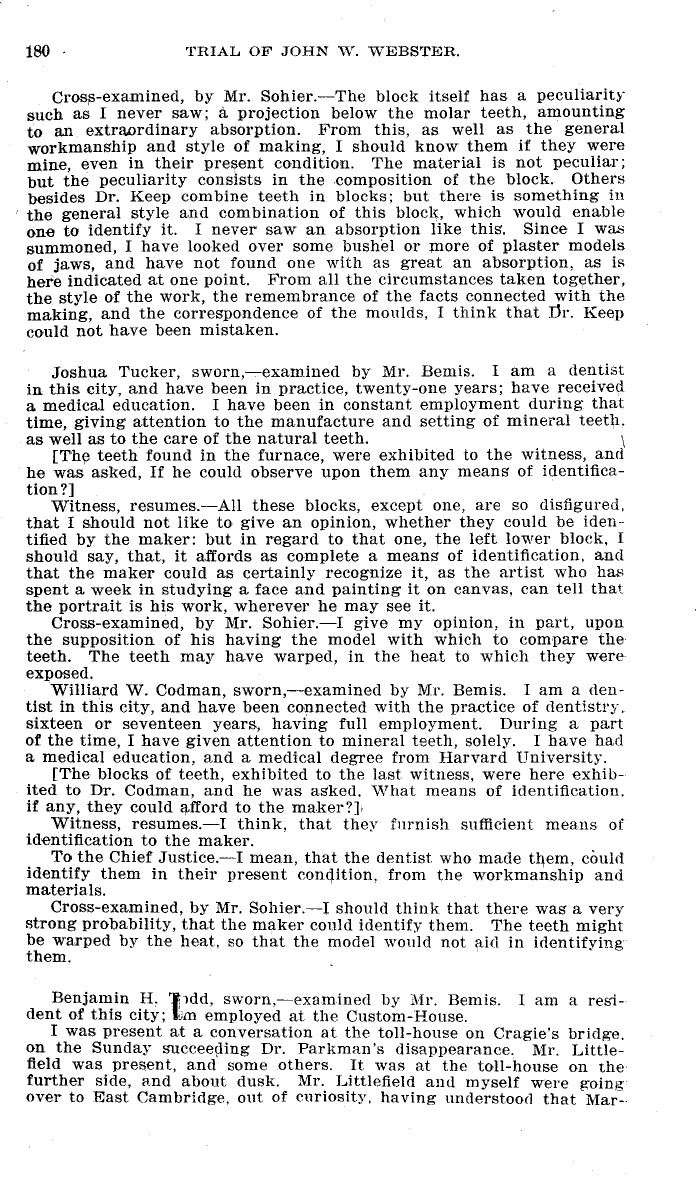|
180 - TRIAL OF JOHN W. W EBSTER.
Cross-examined, by Mr. Sohier.-The block itself has a peculiarity such as I
never saw; a, projection below the molar teeth, amounting to an
extraordinary
absorption. From this, as well as the general workmanship and style of
making, I
should know them if they were mine, even in their present condition. The
material
is not peculiar; but the peculiarity consists in the .composition of the
block. Others
besides Dr. Keep combine teeth in blocks; but there is something in the
general
style and combination of this block, which would enable one, to identify
it. I never
saw an absorption like this. Since I was summoned, I have looked over some
bushel
or more of plaster models of jaws, and have not found one with as great an
absorption, as is here indicated at one point. From all the circumstances
taken
together, the style of the work, the remembrance of the facts connected
with the
making, and the correspondence of the moulds, I think that TV Keep could not
have been mistaken.
Joshua Tucker, sworn,-examined by Mr. Bemis. I am a dentist in this city,
and
have been in practice, twenty-one years; have received a medical education.
I have
been in constant employment during that time, giving attention to the
manufacture and setting of mineral teeth. as well as to the care of the
natural
teeth.
[The teeth found in the furnace, were exhibited to the witness, and he was
asked, If he could observe upon them any means of identification?]
Witness, resumes.-All these blocks, except one, are so disfigured, that I
should
not like to give an opinion, whether they could be identified by the maker:
but in
regard to that one, the left lower block, I should say, that, it affords as
complete a
means of identification, and that the maker could as certainly recognize
it, as the
artist who ha: spent a week in studying a face and painting it on canvas,
can tell
that the portrait is his work, wherever he may see it.
Cross-examined, by Mr. Sohier.-I give my opinion, in part, upon the
supposition of his having the model with which to compare the teeth. The
teeth
may have warped, in the heat to which they were exposed.
Williard W. Codman, sworn,-examined by Mr. Bemis. I am a dentist in this
city, and have been connected with the practice of dentistry, sixteen or
seventeen
years, having full employment. During a part of the time, I have given
attention
to mineral teeth, solely. I have had a medical education, and a medical
degree from
Harvard University.
[The blocks of teeth, exhibited to the last witness, were here exhibited to
Dr.
Codman, and he was asked, `'What means of identification, if any, they could
afford to the maker?],
Witness, resumes.-I think, that they furnish sufficient means of
identification
to the maker.
To the Chief Justice.--I mean, that the dentist, who made them, could
identify
them in their present condition. from the workmanship and materials.
Cross-examined, by Mr. Sohier.-I should think that there was a very strong
probability, that the maker could identify them. The teeth might be warped
by the
heat, so that the model would not aid in identifying them.
Benjamin H. 'f)dd, sworn,-examined by 1Ir. Bemis. 1 am a resident of this
city;
1_;m employed at the Custom-House.
I was present at a conversation at the toll-house on Cragie's bridge, on the
Sunday succeeding Dr. Farkman's disappearance. Mr. Littlefield was present,
and
some others. It was at the toll-house on the further side, and about dusk.
Mr.
Littlefield and myself were going over to Fast Cambridge, out of curiosity,
having
understood that Mar-
|

